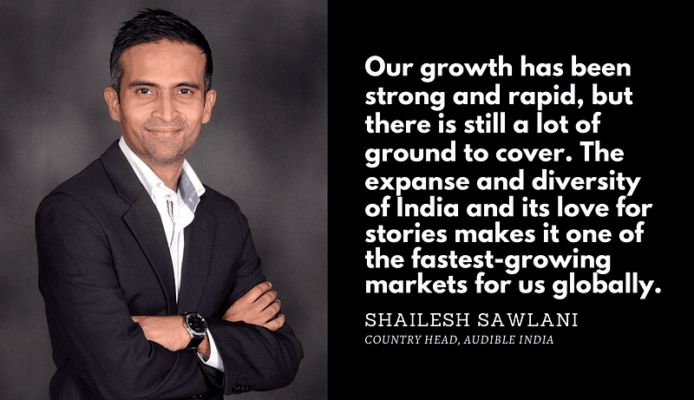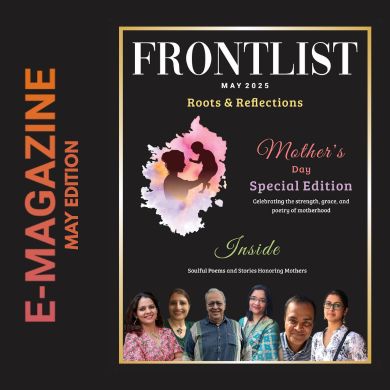Audio books offer screen-free time
Audio books offer screen-free timeon Jul 12, 2021

Audible’s India head Shailesh Sawlani on the growing market for audio books during the pandemic
The last year-and-a-half has changed consumption patterns of digital media with the pandemic-induced lockdown and work-from-home norms. The OTT industry has seen a positive change in its outcome since then, and a Nielsen survey conducted between June-August 2020 pointed to the fact that more readers were spending time on audiobooks. Audible India entered the Indian market in 2018. Globally, the media company, acquired by Amazon in 2008, was the largest distributor and producer to enter the nascent Indian market. Two-and-a-half years on, it has several local titles under its banner. BrandLine spoke to Shailesh Sawlani, Country GM, India, at Audible about the growing business of audiobooks and what makes them popular in India. Some excerpts:
How has Audible adapted to country-specific tastes and preferences?
We began with our premium service, priced at ₹199 a month in India, in which you get the best books from all over the world from international bestsellers to local favourites. We have all the top bestselling author books such as Chetan Bhagat, Aruni Kashyap, Durjoy Dutta — to name a few. What we also did in December 2019 — is launch a free-of-cost service — a standalone app called Audible Suno. This is completely free, ad-free to get more creators interested in creating content. Our plan is to reach really wide segments in India. That is why, for the first time ever, we have an app which you can use without having to put your credit card details, or signing up. It was a conscious decision on our part to keep it such to scale audio content in India. We feel that the free app has helped with accelerated adoption. India has been one of the fastest growing audiences for Audible globally. People want access to quality content and get screen-free time — audio fits in beautifully in their lives.
Have there been any changes in adoption patterns over the last two years during the pandemic?
Earlier, we would see peaks (in user traffic to the app) in the morning and evening, assuming when people were travelling, but that stopped, and got distributed. Now we see a smoother line throughout the day. People have been listening to content any time in the day, while doing various chores, whether they listen with their kids or otherwise. For instance, I have a three-and-a-half year old who listens to Topsy and Tim, his favourite audiobook for easily half-an-hour in a day. We saw early morning spikes during exercising, and morning walks and so on. A little bit of a bump around lunchtime, as a break from the routine.
How did you confirm that users have started spending more time reading e-books and audio books?
People had access to their IoT devices because of more time spent at home, and this changed the consumption patterns for some in the last few months. Having to entertain kids of all ages at home also contributed to this. We started a free service called Audible Kids for this purpose. Again, it is something you can log into from your browser, and listen. We expanded our collection to include popular titles such as Panchatantra and Karadi Tales in India.
What kind of books were popular during the lockdown?
We witnessed a change in consumption pattern, and also a little bit of an inclination towards spirituality and wellness titles. Popular titles such as The Power of the Subconscious Mind or My Gita by Devdutt Pattanaik remained so. We saw more than unusual consumptions on these books. We also tried to create content in the lockdown, without our partners being able to go to the studios. We had the likes of Nilesh Mishra, who is a popular storyteller on radio with a massive YouTube following, make a series for us. It was called Qisse Lockdown Ke. Sanjeev Kapoor did a cooking show for us, Devdutt Pattanaik did a series called Suno Mahabharat. All of this was produced during lockdown. Globally, Audible rolled out a collection to help people sleep better. It’s got some celebrity names such as Nick Jonas attached to it. .
What are the languages you are planning to publish in Audible?
We publish titles in English and Hindi, and a small selection of Tamil. We offer a vast collection in Hindi and English, but plan to expand to other regional languages when we will be able to offer a comprehensive collection to people.
Has Audible commissioned any translations, and is there a market for it?
If you looking at our bestsellers, a lot of them are Hindi translations of Dale Carnegie’s How to Win Friends and Influence People, Yuval Noah Harari’s Sapiens: A Brief History of Mankind, Rich Dad Poor Dad, among others. International bestsellers tend to be popular in Hindi as well. We haven’t done much in the area of translating from regional languages yet.
What do audiobooks have to offer over paperbacks?
We talk about this industry in terms of the three Vs — voice, vernacular and video. So, we always think of audiobooks as a complete experience — there’s the story, there’s the quality of the narration, quality of production, that really transports you to another place. It is beautiful that while you’re doing something, someone tells you a story. Its not just something you listen to distract yourself — it is a work of art which is an experience while doing a mundane task. It is an attempt at finding that extra time for yourselfThat’s why an audiobook.
How do you deal with piracy especially in India?
Ultimately we are offering a service that’s unique so we hope to get customers who come to us also for the experience of the platform. We are a global business. Piracy is handled at a global level.
Is Audible going to explore educational audio books, as education is a big chunk of Indian publishing?
Education is harder with audiobooks, especially STEM courses, but if it is something like a 10-day MBA complemented with a PDF, supplementary reading that adds value to one’s career and life, we can look into that. Currently, we want to focus on the fiction and non-fiction space.
SOURCE - THE HINDU BUSINESS LINE



.jpg)






.jpg)

.jpg)
.jpg)
.jpg)
.jpg)
.jpg)
.jpg)










Sorry! No comment found for this post.